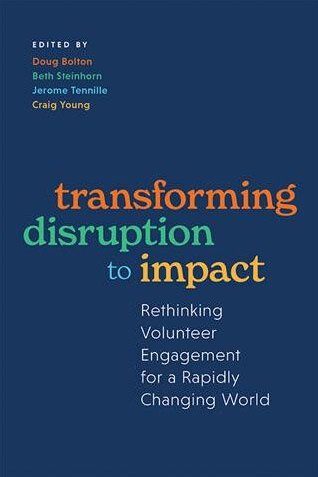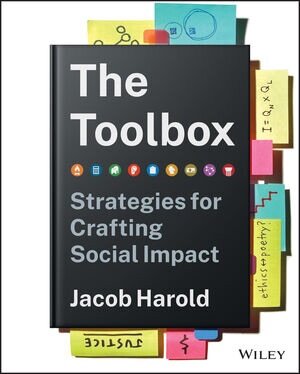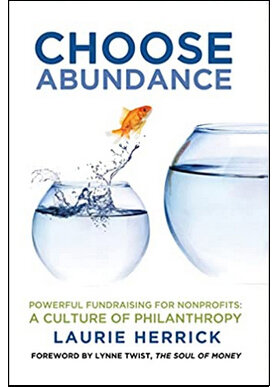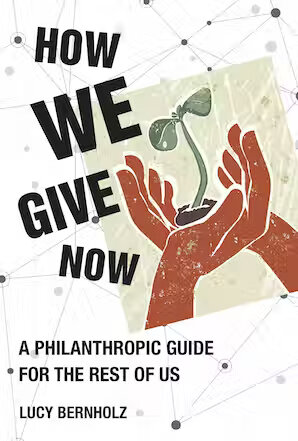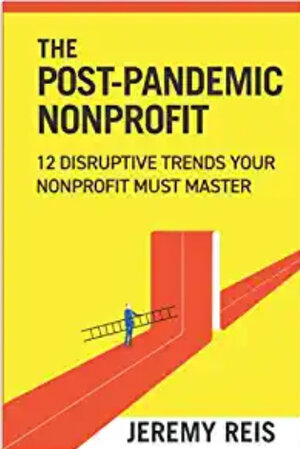Transforming Disruption to Impact: Rethinking Volunteer Engagement for a Rapidly Changing World
The twin crises of 2020—the COVID-19 pandemic and the murder of George Floyd—led to a disruption of standard nonprofit operations almost immediately. But as the editors of Transforming Disruption to Impact: Rethinking Volunteer Engagement for a Rapidly Changing World recognize, “disruption is not inherently bad.” While there was nothing to celebrate in those cataclysmic events, they drove many individuals and nonprofits to react quickly and to improve operations—to innovate, change, and “build back better.”
The 19 essays collected in this book, penned by national nonprofit leaders, experts in volunteerism, directors of corporate social responsibility, and grantmakers, examine the changes wrought by disruption in 2020 through the lens of volunteer engagement. The focus of the book is to draw attention to what was inadequate about nonprofit volunteering in the past—and how nonprofits, corporations, funders, and individuals have worked to change processes for the better.
The book is divided into four thematic sections that help define the landscape of volunteering and its transformation: Section One defines the “landscape of disruption,” including the effects of the pandemic and the racial inequities and injustices revealed by the interruption of standard volunteering practices; Section Two helps rethink the standard strategies of volunteering and how the roles of corporations, funders, volunteers, and leaders evolved after 2020; Section Three redefines the operations of volunteer engagement, from rethinking recruitment processes to the groundbreaking uses of technology; and Section Four takes a look at the impact of all this change and the need for continued change to increase intended impacts.
The discrete essays look at the experiences of specific nonprofits, from new national volunteering nonprofits like Inspiring Service and Develop for Good to longtime local food service providers like the 100-year-old East Boston Social Centers. However, there are issues that wind through all of these essays—issues that became obvious once the disruption of services were felt. Among the most crucial are the following:
Equity and volunteerism: As many of the essays reveal, the response to George Floyd’s murder at the hands of Minneapolis police inspired a change in their communities, despite the omnipresent threat of COVID—and this change made itself felt through volunteerism. As Karmit Bulman, executive director of the Minnesota Alliance for Volunteer Advancement notes, there was an unexpected emotional call to volunteer: “What motivated thousands of us to flock to what is now known as ‘George Floyd Square’ with our shovels, garbage bags, and hygiene supplies to clean up neighborhoods torn apart by civil unrest? No one organized us. No formal organization called upon us to do community clean-up. What motivated us to leave our COVID cocoons?” Bulman notes that this “informal” volunteering—driven by personal responsibility and the urge to connect to people—drew attention to the fact that previous “formal approaches to volunteer engagement may unintentionally create barriers for many people who wish to volunteer.”
The focus of the book is to draw attention to what was inadequate about nonprofit volunteering in the past—and how nonprofits, corporations, funders, and individuals have worked to change processes for the better.
The sense that unintentional barriers were revealed is clear to many of the other essayists, including Doug Bolton of Inspiring Service, who notes that the traditional methods of recruiting volunteer board members failed in creating “WIDER-welcoming, inclusive, diverse, equitable, and representative—nonprofit boards.” Wendy Vang-Roberts, training director of the Minnesota Alliance for Volunteer Advancement, relates how, during COVID, “best practices” in volunteer recruitment were shown to be non-inclusive: “Many of these practices…actually reinforce systems of power and privilege, thereby inadvertently excluding historically marginalized communities.” These exclusionary practices work many different ways. Phyllis N. Segall, senior fellow at Encore.org (now CoGenerate), discusses how, for years, volunteer programs like Civilian Conservation Corps and the Foster Grandparents Programs segregated volunteers by age; “disruption-driven innovation”—breaking down age barriers through programs like Colorado’s intergenerational COVID Containment Response Corps—led to a more successful sharing of volunteer effort (and wisdom, and skills) by old and young alike.
Technology: Many organizations used new technology to counteract many of the problems of inclusivity discussed above. As Laura Plato, former chief solutions officer for VolunteerMatch says, “[W]e saw the emergence of grassroots mutual aid movements, organized around principles and systems characterized by easy-to-use, often low-fi, technologies and distributed leadership.” The necessity of immediate changes due to the threat of COVID to those served led to realizations that the technology could not cope“[A]n antiquated website might have been tolerable in normal times…it became devastating as the world turned virtual and organizations were forced to rely on their online presence to connect with beneficiaries, volunteers, and donors.” This latter quote is from Amay Aggarwal and Mary Zhu, part of the group of Stanford students that led to the startup Develop for Good. Develop for Good began with Google Forms uniting volunteer tech students across the country to assist nonprofits in need. At a more complex technological level, Inspiring Service created a less exclusionary board matching program using artificial intelligence and a virtual platform. In the last essay of the book, Craig Young, president of the Craig Young Family Foundation, calls for even more technological innovation for nonprofit volunteers: “the impact possible from potential applications that leverage a well-maintained, comprehensive active nonprofit guide are vast and promising.”
A new look at volunteering itself: One of the most valuable things about this essay collection is the way it uses the disruption of the moment to look at how individuals are changing many aspects of volunteering away from “the way it’s always been done.” For example, corporate responsibility and social impact strategist Jerome Tennille takes a sharp look at corporate social responsibility (CSR) in the post-COVID world and calls for an embrace of “big, hairy, audacious goals,” including more concentration on informal volunteering and investing in true in-house CSR expertise. Tennille and Beth Steinhorn of VQ Volunteer Strategies look at how corporate in-service days have often put stress on the nonprofits they supposedly serve, and how, given the immediacy of need during 2020 and 2021, “many organizations relegated days of service to a relic of the past, giving life, instead, to new, ongoing opportunities….” The focus in many of the essays is less on “making a difference” in the sense of heroically delivering change to a nonprofit. Instead, it’s about connecting to and understanding the real lives of the beneficiaries of volunteering—or, as Chris Jarvis and Angela Parker of the Realized Worth Institute describe it, that a poor person is not a problem to be solved but a person whose life you must imagine, connect to, and challenge your own assumptions about.
The final message—and what makes the book so impactful itself—is its emphasis on volunteer impact, and the meaning of all the changes that 2020 made necessary.
These issues are just a sample of the scope of this literally disruptive book. The final message—and what makes the book so impactful itself—is its emphasis on volunteer impact, and the meaning of all the changes that 2020 made necessary. In her essay, consultant Sue Carter Kahl states that the movement of all volunteer programs should be away from unexamined “best practices” and a solely economic examination of volunteering. She points to the importance of focusing on worth rather than value. “Value is a business term and suggests a price set by the market. Worth is more comprehensive. It includes material value, but it can also be imbued with meaning, sentiment, and tradition. It reflects not only the item or time given but the relationship between those in the exchange.”
The worth of volunteering, says this excellent book, is connection.
David M. Holmes is a network engagement manager at Candid.


